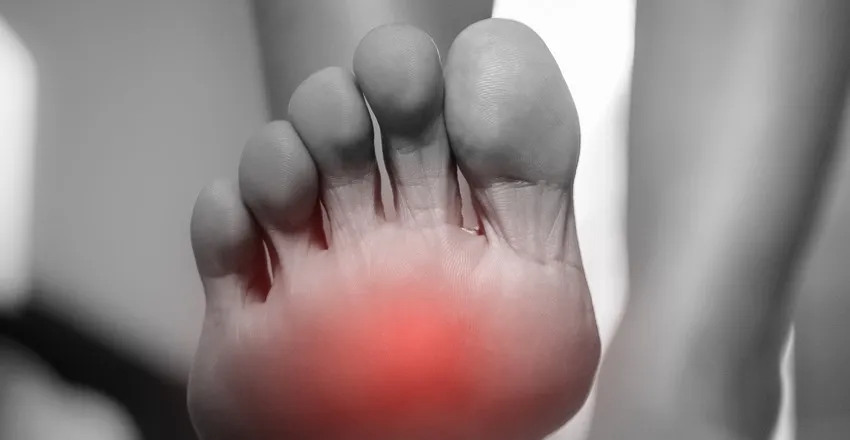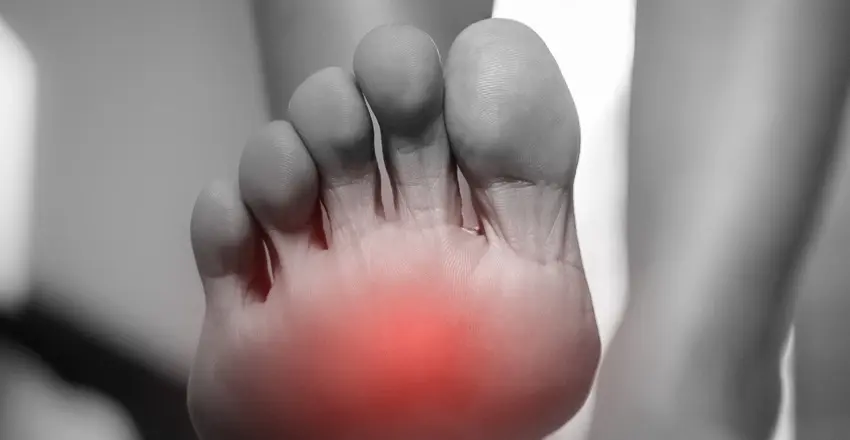what to do when you have heel fat pad irritation
 How to Treat Painful Fat Pad Atrophy in the Pes
How to Treat Painful Fat Pad Atrophy in the Pes
(Testimonial for Sole-Make full; resolved pain to ball of foot pain, 30 y/o Female person)
Atrophy of the fat pad on the plantar attribute of the foot is a common condition that affects the heel or the forefoot, oft referred to equally the "ball" of the foot.
Over the past few years, the treatment modalities for fat pad atrophy have been gaining momentum in the field of foot and talocrural joint surgery.
When you are walking, a force per unit area that equals more than 2.5 times your trunk weight can apply to your heel and front of your human foot. Consequently, the fat pads, which are necessary to cushion these areas, may undergo atrophy and degenerate. Heel pain and pain to the front of your foot can be mistaken for plantar fasciitis in the heel or neuroma hurting in the ball of your foot.
Wearing loftier heel shoes, standing on hard surfaces for long periods of time and sure activities like squats and lunges tin can put excessive mechanical stress and pressure on the balls of your feet which can contribute to plantar fat pad cloudburst. Another common term used to describe plantar fat pad cloudburst in the front of your foot is metatarsalgia. Getting older and certain diseases tin can also increment the likelihood of fat pad atrophy.
The Foot and Talocrural joint Surgeons at Foot HealthCare Associates know how to treat painful fat pad atrophy in the foot. They take helped develop and refine techniques to augment and create new fatty pads and cushioning, for those suffering with the pain of plantar fat pad atrophy. One of the non-invasive treatments developed at Foot HealthCare Assembly is called "Sole-Fill™".
In this article, nosotros will briefly talk over the office of the fat pads in your human foot, symptoms of fat pad atrophy, too as the available treatment options for this condition.
What is the fat pad?
The fatty pad is a thick collection of connective tissue that runs underneath the brawl of the pes and the heel.
The purpose of the pad includes:
- Providing a cushioning arrangement to minimize the effect of force per unit area, friction, and gravitational forces on the nutrient.
- Serving equally a mechanical anchor to shift the torso weight without overwhelming connective tissues.
What is Fat Pad Atrophy?
Fatty pad cloudburst refers to the gradual loss of the fat pad in the ball or heel of the pes.
This condition is characterized past the thinning of the pad, which exposes the sensitive connective tissues to strain and pressure. Equally a result, inflammation and micro-tears occur.
Patients often report severe symptoms of pain and discomfort.
Other symptoms of fat pad atrophy include:
- Pain in the foot that becomes worse after wearing high heels or walking on a hard, flat surface.
- Painful sensations after spending long hours continuing.
- Sensing the evolution of edema in your foot or heel.
- Callus germination in the ball of the foot makes it experience thicker.
Who is at take a chance of getting Fat Pad Cloudburst?
The hazard of developing fatty pad atrophy is relatively like between the two genders.
With that said, some experts suggest that females are more susceptible to developing fat pad atrophy due to:
- Wearing high heels
- Ill-plumbing equipment tight footgear
The following factors as well increase the adventure of fat pad atrophy:
Age : fat pad atrophy belongs to a large spectrum of diseases known as degenerative foot conditions. Equally you age, the production of new cartilage and fat tissues slows downward, which makes the bones weaker and prone to injury.
Footwear : equally mentioned above, wearing tight-fitting shoes might increase the risk of footpad atrophy. In the best-instance scenario, this habit volition deteriorate an already existing status.
Injury : injuries endured afterwards an accident are common triggers for fat pad cloudburst, especially if several surgeries are performed in the pes area.
Family history : having a family history of fat pad atrophy seems to play an important role in developing this condition.
Arthritis : the active inflammation of the joints exacerbates fat pad condition and increases the adventure of their cloudburst.
Diabetes : chronically elevated claret force per unit area increases the chance of peripheral neuropathy – a condition that precipitates pressure level-induced atrophy of the fat pad.
Medications : the chronic employ of corticosteroids may induce the atrophy of fatty pad in adults.
The treatment modalities for fat pad atrophy
Conservative handling
The mainstays of treatment for heel fatty pad cloudburst are custom molded pes orthoses with padding, shoes that provide padding and back up for the feet while walking, and heel cups or cushioned socks that help reduce the impact of walking on the human foot, experts say.
"Bourgeois handling can be quite successful; it can ease pain and forbid symptoms from getting worse. The idea is to supervene upon the fat pad with daze absorption from the outside of the foot. As a result, pressure on the human foot—especially on the bones and skin, where at that place is oftentimes harm that seriously impacts health—tin exist relieved," said John Steinberg, DPM, chief of podiatric surgery at Medstar Georgetown Hospital in Washington, DC. "Unfortunately, we often become pushback from patients who don't want to be burdened with wearing an orthotic that they must transfer from shoe to shoe, or to take to wear a shoe that looks orthopedic."
Thus, it is vital to brainwash patients near the importance of wearing foot orthoses throughout the day and the all-time means to cull proper footwear that is sturdy and cushioned, Steinberg said.
Patients with heel fat pad atrophy often do well with viscoelastic orthotic devices, heel cushions, and heel cups—and any fabric that has at to the lowest degree three to 5 mm of cushion, Kor said. Orthoses should too accept a cushioned topcover, such every bit those made of closed-cell polyethylene cream.
"Yous want a covering that is cushioned, but likewise does non suspension down over a short period of time," Kor said.
In addition to these conservative treatments, interventions that involve injecting materials into the human foot have been tried—with varying degrees of success. One technique is to inject silicone into the pes, but this technique is controversial, since the silicone tin can drift over time.8,9 Complications from injecting a foreign substance in the human foot are also possible, Hanna said.
Another method used by some clinicians is to inject dermal fillers into the foot, a procedure similar to those in which fillers are injected in the face to address wrinkles. These materials include products made with poly-L-lactic acrid and hyaluronic acid, only they are not Food and Drug Administration-canonical for use in the foot, and enquiry into their efficacy for heel fatty pad atrophy has been express, Hanna said.
(Testimonial for Sole-Fill; resolved pain to brawl of foot hurting, threescore y/o Female )
Fat grafting
One of the newest methods for how to treat painful fatty pad atrophy is autologous fat grafting, or lipofilling, in which fat from other anatomical sites is injected into the bottom of the pes. Autologous fatty grafting for the human foot has been used since the 1990s, but early scientific studies on this technique were dogged with issues, especially necrosis of the fatty. Recent inquiry, still, has documented the effectiveness of autologous fatty grafting for both pedal and heel fat pad atrophy.
In one written report published in The Foot in 2014, a team of Italian researchers injected fat harvested from the abdomen in 4 patients during two sequential injections performed over 12 weeks.10 The iv patients in the report had previously undergone repair of post-traumatic soft tissue loss of the foot with peel grafts and, in one example, a cross-leg fascio-cutaneous flap. All of the patients had pain in the plantar aspect of the foot after their surgeries, had difficulty begetting weight on the heel, and showed skin instability with recurrent ulcerations and callus formation. The heel fat pad injections were aimed at thickening the tissue at the plantar sole and increasing the weightbearing capability of the foot.
All four patients demonstrated restoration of the fatty pad tissue and the functional construction of the sole of the foot after the lipofilling procedure, according to atomic number 82 author Giovanni Nicoletti, MD, a plastic and reconstructive surgeon in the department of clinical, surgical, diagnostic, and pediatric sciences at the University of Pavia in Italia.
During recovery, the patients were advised to avoid dynamic and static plantar weightbearing for ii weeks. And so, xxx% fractional dynamic and static plantar weightbearing was allowed, using crutches and soft socks, for two weeks. In the terminal two weeks of recovery, the patients could engage in total dynamic and static plantar weightbearing, wearing custom plantar insoles, custom shoes, or both.
All four patients experienced good outcomes from the surgery with no serious complications. Nevertheless, clinicians should be aware of the risk of potentially serious complications associated with these procedures, including infection and fat necrosis from failed adipose tissue engraftment,10 Nicoletti said.
Fat grafting has also been tried every bit a means of preventing reulceration in loftier-risk diabetic feet. In a instance written report published in Plastic and Reconstructive Surgery Global Open,11 David Armstrong, DPM, Doc, PhD, and colleagues used fatty augmentation to address plantar fat pad atrophy and recalcitrant preulcerative lesions in a patient anile 37 years with type 2 diabetes who had previously undergone tibialis anterior tendon transfer for a progressive chronic styloid ulcer. Later four weeks in a splint, the patient successfully transitioned to normal shoe gear, and had no complications or recurrence of his wound at 6 weeks, Armstrong says.
"The question we asked was: Volition this type of grafting concur up? It appears it volition, although nosotros don't have good long-term data yet," said Armstrong, a professor of surgery at the University of Arizona and deputy director of the Arizona Eye for Accelerated Biomedical Innovation in Tucson. "By using the technique of fatty grafting for heel fat pad atrophy, nosotros give our patients with diabetes time to recover from ulcers, reduce stress on the feet, and subtract the run a risk of ulcers. We can heal many of our diabetic patients with ulcers past using other techniques, but the existent tough nut to crack is keeping these patients healed and giving them quality of life."
As well equally being a reconstructive surgery, the procedure was a ways to attain tissue repair, he said.
"Thus, we could interrupt the cycle of reulceration in the diabetic foot and keep patients with diabetes and diabetic neuropathy in remission [ulcer-free]," Armstrong said.
If y'all suffer from the hurting of fatty pad atrophy and you lot live in or around the post-obit areas, yous can book an appointment with a physician at Michigan Podiatry by clicking on this link :
- Livonia, Michigan.
- Novi, Michigan.
- Southfield, Michigan.
- Howell, Michigan.
Takeaway bulletin
Footpad atrophy is a common condition that affects the ball and heel of the foot. The prompt handling of this condition by one of the treatments listed tin can often provide dramatic relief and improve your quality of life.
The Doctors at Foot Healthcare Associates know how to treat painful fat pad atrophy. If y'all want to learn more, check out this link .
Sole-Fill up Testimonial: Resolved Brawl of Human foot Pain 70y/o Male person
Source: https://www.michiganpodiatry.com/treat-painful-fat-pad-atrophy-in-the-foot/
 How to Treat Painful Fat Pad Atrophy in the Pes
How to Treat Painful Fat Pad Atrophy in the Pes
0 Response to "what to do when you have heel fat pad irritation"
Enregistrer un commentaire